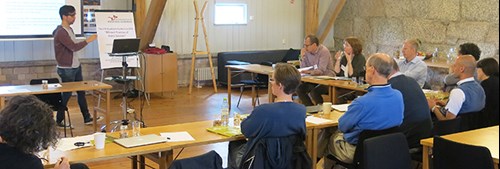Please read a summary of the conference.
Examples of research presented in Vaxholm:
Can pay-for-performance stimulate appropriate use of antibiotics, was the question asked by Lina Maria Ellegård, Lund University. She has studied instituted incentives, in primary care in eight counties, to prescribe narrow-spectrum antibiotics, instead of broad-spectrum antibiotics. She found that pay-for-performance made no change in the overall level of prescription of antibiotics. Though, pay-for-performance significantly increased the share of narrow-spectrum antibiotics. Some of the non-Swedish researchers pointed out that this is in a country where half of the prescribed antibiotics are narrow-spectrum. In the US the equivalent number is 7% and in the EU 9%.

Susan Dynarski, Universityof Michigan – National Bureau of Economic Research, presenting the study ”Stand and Deliver: Effects of Bost on’s Charter High Schools on College Preparation, Entry, and Choice”.
In the afternoon of the first day Marika Cabral, University of Texas at Austin, presented a study about disability insurance: ”Estimating the Value of Public Insurance Using Complementary Private Insurance”. “I am trying to quantify the advantage of having social insurance. And the willingness to supplement the public insurance with private insurance,” said Cabral. The research applies to disability insurance which covers more than 8 million Americans.
The analysis by Cabral suggests that “public disability insurance generates substantial surplus for this population, and there may be gains to increasing the generosity of coverage in this context”. Though, measured from the government's point of view, it would not be worthwhile to expand the public insurance as there is a viable market for private insurance.

Simon Burgess, University of Bristol and Centre for Analysis of Social Exclusion, presenting his study ”Market Forces in England’s Schools.”

Gabriel Heller Sahlgren, London School of Economics and IFN, commenting on ”Unexpected School Reform: Academisation of Primary Schools in England” by Sandra McNally, London School of Economics and University of Surrey.
Henrik Jordahl, IFN, presented a paper titled “Profit in Public Services: An Experimental Opinion Survey”. “Public opinion is not always formed rationally. In Sweden today we have a really strong opinion against profit making in the welfare system,” explained Henrik Jordahl to the researchers from abroad. The operating margin in for-profit-companies in the welfare sector is 5%. “Many believe it is over 40%!” said Jordahl adding that the higher the overestimation, the more positive is the respondent towards a political proposal to put a legal limit to dividends in the tax-financed service sector. “Informing people about the actual average operating margin in the sector reduces their support for limiting dividends considerably.”
 Ola Andersson, IFN, discussion the study ”Market Forces in England’s Schools” by Simon Burgess.
Ola Andersson, IFN, discussion the study ”Market Forces in England’s Schools” by Simon Burgess.

Lina Maria Ellegård, Lund University, talking about the paper ”Can Pay-for-Performance to Primary Care Providers Stimulate Appropriate Use of Antibiotics?"

Marika Cabral, University of Texas at Austin, explaining her study ”Estimating the Value of Public Insurance Using Complementary Private Insurance."

Henrik Jordahl, IFN, explaing his study “Profit in Public Services: An Experimental Opinion Survey" to the researchers from Sweden, US and Britain,

Lovisa Persson, IFN, commented on the study ”Estimating the Value of Public Insurance Using Complementary Private Insurance” presented by Marika Cabral.

